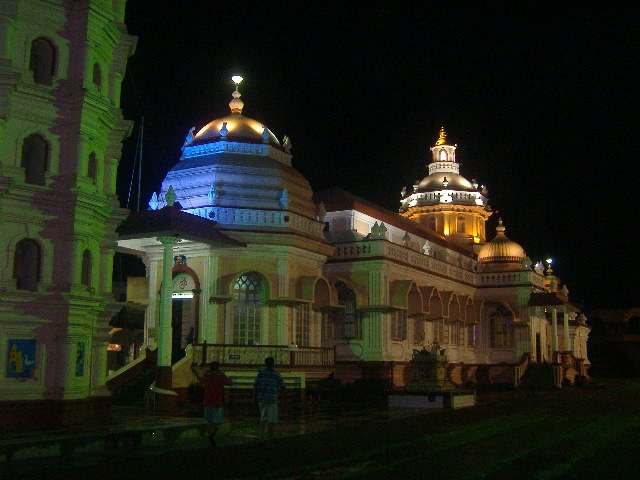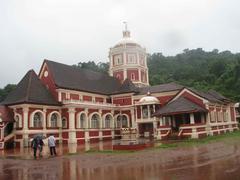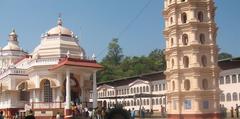
Visiting Shri Manguesh Temple: Hours, Tickets, and Tips
Date: 17/07/2024
Introduction
Nestled in the serene town of Ponda, Goa, the Shri Manguesh Temple stands as a beacon of historical and cultural significance. This revered Hindu temple, dedicated to Lord Manguesh, an incarnation of Lord Shiva, is not only a spiritual haven but also an architectural marvel. Originally established in the 16th century in Kushasthali (present-day Cortalim), the temple was relocated to Ponda to protect it from Portuguese proselytization efforts (Goa Tourism). Over the centuries, the temple has undergone numerous renovations and expansions, reflecting a blend of traditional Hindu and Portuguese architectural styles (Goa Heritage). Today, it stands as a testament to the resilience and devotion of the Goan Hindu community, drawing thousands of visitors each year. This guide aims to provide a comprehensive overview of the temple’s rich history, cultural significance, and practical visitor information, including ticket prices, visiting hours, and travel tips, ensuring a respectful and enriching experience for all who visit.
Table of Contents
- [Introduction](#introductionintroduction)
- [History of Shri Manguesh Temple](#history-of-shri-manguesh-templehistory-of-shri-manguesh-temple)
- [Origins and Early History](#origins-and-early-historyorigins-and-early-history)
- [Relocation and Reconstruction](#relocation-and-reconstructionrelocation-and-reconstruction)
- [Architectural Evolution](#architectural-evolutionarchitectural-evolution)
- [The Maratha Influence](#the-maratha-influencethe-maratha-influence)
- [Post-Independence Developments](#post-independence-developmentspost-independence-developments)
- [Visitor Information](#visitor-informationvisitor-information)
- [Visiting Hours and Ticket Prices](#visiting-hours-and-ticket-pricesvisiting-hours-and-ticket-prices)
- [Travel Tips](#travel-tipstravel-tips)
- [Accessibility](#accessibilityaccessibility)
- [Cultural Significance](#cultural-significancecultural-significance)
- [Religious Practices and Festivals](#religious-practices-and-festivalsreligious-practices-and-festivals)
- [Cultural Impact on the Local Community](#cultural-impact-on-the-local-communitycultural-impact-on-the-local-community)
- [Influence on Goan Art and Literature](#influence-on-goan-art-and-literatureinfluence-on-goan-art-and-literature)
- [Modern-Day Relevance](#modern-day-relevancemodern-day-relevance)
- [Preservation Efforts](#preservation-effortspreservation-efforts)
- [Frequently Asked Questions (FAQ)](#frequently-asked-questions-faqfrequently-asked-questions-faq)
- [Conclusion](#conclusionconclusion)
History of Shri Manguesh Temple
Origins and Early History
The Shri Manguesh Temple, located in Ponda, Goa, is one of the most revered and ancient temples in India. Dedicated to Lord Manguesh, an incarnation of Lord Shiva, the temple’s origins date back to the 16th century during Portuguese colonization. Initially situated in Kushasthali (present-day Cortalim), the temple was moved to Ponda to protect it from Portuguese proselytization efforts (Goa Tourism).
Relocation and Reconstruction
In 1560, the Portuguese began converting the local Hindu population to Christianity, destroying many Hindu temples. To safeguard the deity, the idol of Lord Manguesh was clandestinely transported to Priol in Ponda, under the Hindu-friendly Adil Shahi dynasty of Bijapur. The temple was reconstructed in its new location, with the current structure completed in 1565 (Goa Heritage).
Architectural Evolution
The Shri Manguesh Temple has undergone several renovations and expansions over the centuries. Initially modest, the temple gained prominence and saw significant architectural enhancements. The complex now includes a grand entrance, a spacious courtyard, and a magnificent water tank—common features in Goan temples. The architecture blends traditional Hindu and Portuguese styles, reflecting the region’s cultural amalgamation (Goa Tourism).
The Maratha Influence
In the 18th century, the Marathas, led by Chhatrapati Shivaji Maharaj, played a crucial role in the temple’s history. Known for their patronage of Hindu temples, the Marathas supported the maintenance and expansion of the Shri Manguesh Temple. This period saw the addition of structures like the Deepastambha (lamp tower) and the Sabha Mandap (assembly hall), integral parts of the complex today (Maratha History).
Post-Independence Developments
After India gained independence in 1947, the Shri Manguesh Temple continued to be a focal point of religious and cultural activities in Goa. The temple management undertook several initiatives to preserve and promote the temple’s heritage. In the 1970s, a major renovation project restored the temple’s intricate carvings, frescoes, and architectural elements (Goa Heritage).
Visitor Information
Visiting Hours and Ticket Prices
The Shri Manguesh Temple is open to visitors from 6:00 AM to 10:00 PM every day. Entry is free, but donations are welcomed to support the temple’s upkeep and activities. For special events and festivals, it is advisable to check the temple’s official website or contact the management for updated visiting hours and any potential entry fees.
Travel Tips
- Dress Code: Visitors are advised to dress modestly. Traditional Indian attire is preferred, and shoes must be removed before entering the temple premises.
- Best Time to Visit: The best time to visit is during the early morning or late evening to avoid the heat and crowds. The annual Jatra festival is a particularly vibrant time to experience the temple’s cultural significance.
- Nearby Attractions: Ponda is home to several other historical sites, including the Shantadurga Temple and the Safa Masjid. The Sahakari Spice Farm, located nearby, offers a unique insight into Goa’s agricultural heritage.
Accessibility
The temple is accessible by road, with ample parking available nearby. Public transport options include buses and taxis from major Goan cities like Panaji and Margao.
Cultural Significance
Religious Practices and Festivals
The Shri Manguesh Temple is not just a place of worship but also a cultural hub. It hosts several festivals and events throughout the year, attracting devotees and tourists worldwide. The most significant festival is the annual Jatra, celebrated with great pomp and splendor. The temple also plays a vital role in preserving traditional Goan music and dance forms, such as the Mando and the Dekhni (Goa Tourism).
Cultural Impact on the Local Community
The temple plays a crucial role in the cultural and social life of the local community. It serves as a center for various cultural activities, including classical music and dance performances, religious discourses, and community gatherings. The temple’s management also engages in various philanthropic activities, such as providing scholarships to students and organizing health camps (Goa Tourism).
Influence on Goan Art and Literature
Shri Manguesh Temple has significantly influenced Goan art and literature. The temple’s rich history and religious significance have inspired numerous works of art, including paintings, sculptures, and literary compositions. Many local artists and writers draw inspiration from the temple’s architecture, rituals, and festivals, contributing to the preservation and promotion of Goan culture (Goa Tourism).
Modern-Day Relevance
Preservation Efforts
In recent years, there has been a concerted effort to preserve the temple’s historical and cultural heritage. The Archaeological Survey of India (ASI) has listed the Shri Manguesh Temple as a protected monument, ensuring that it receives the necessary attention and resources for its upkeep. Additionally, several non-governmental organizations (NGOs) and cultural bodies have been actively involved in promoting the temple’s heritage through various initiatives, including heritage walks, cultural festivals, and educational programs (ASI).
Frequently Asked Questions (FAQ)
Q: What are the visiting hours of Shri Manguesh Temple?
A: The temple is open from 6:00 AM to 10:00 PM daily.
Q: How to get tickets for Shri Manguesh Temple?
A: Entry is free, but donations are welcomed.
Q: What is the best time to visit Shri Manguesh Temple?
A: Early morning or late evening is the best time to avoid the heat and crowds.
Q: Are there any special events at Shri Manguesh Temple?
A: The annual Jatra festival is the most significant event, celebrated with great pomp and splendor.
Conclusion
Shri Manguesh Temple is more than just a place of worship; it is a cultural landmark that embodies the rich heritage of Goa. From its origins in the 16th century to its modern-day significance, the temple has stood the test of time, evolving and adapting to the changing socio-political landscape. Its architectural splendor, cultural significance, and spiritual aura make it a must-visit destination for anyone interested in exploring Goa’s heritage. The temple continues to play a crucial role in the cultural and social life of the local community, hosting numerous festivals and events throughout the year. Moreover, concerted efforts by the Archaeological Survey of India (ASI) and various cultural organizations ensure the preservation of this historic site for future generations (Goa Heritage; ASI). Whether you are a devotee, a history enthusiast, or a cultural explorer, visiting Shri Manguesh Temple promises a memorable and enriching experience. For more information and to plan your visit, download the Audiala mobile app, check out other related posts, and follow us on social media for updates.


